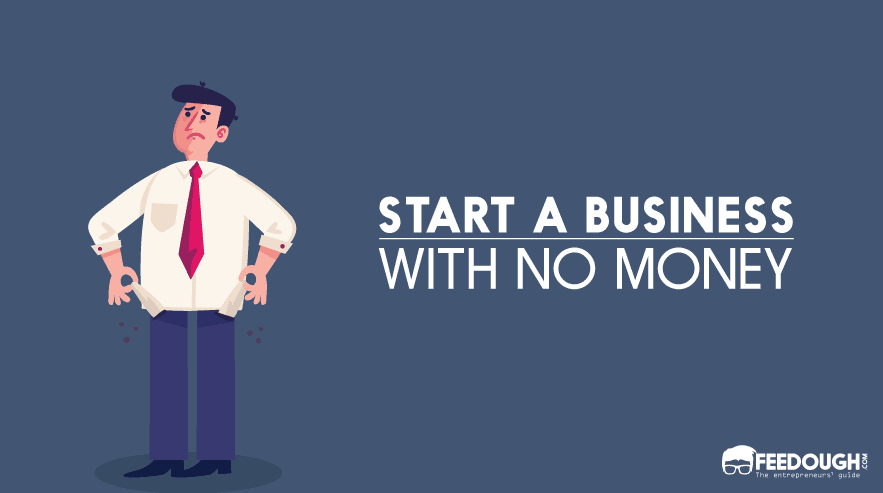
Starting a business can feel like a daunting task, especially when you imagine needing a hefty bank account, a fancy office, and a team of experts. But what if I told you that the most valuable asset you possess isn’t money, but your creativity, skills, and determination?
The truth is, many successful businesses started with little to no capital, relying instead on bootstrapping, ingenuity, and leveraging free resources. This comprehensive guide will walk you through the exciting journey of how to start a business with no money, turning your entrepreneurial dreams into a tangible reality.
The Myth of Needing Money to Start a Business
Let’s debunk the biggest myth first: you absolutely do not need a lot of money to start a business. While capital can certainly accelerate growth, it’s often a crutch that prevents aspiring entrepreneurs from thinking resourcefully.
What you do need:
- A Problem to Solve: Every successful business addresses a need or solves a problem for its target audience.
- A Skill or Passion: What are you good at? What do you love doing? This is your initial product or service.
- Grit and Persistence: Starting with no money means you’ll face challenges, but your ability to adapt and keep going will be your superpower.
- Resourcefulness: How can you achieve your goals using free tools, existing networks, and your own two hands?
This approach, known as bootstrapping, is about building a business from the ground up using only personal finances or the operating revenues of the new company. It forces you to be lean, efficient, and truly understand what your customers value.
Your Step-by-Step Guide to Starting a Business with No Money
Let’s break down the process into actionable steps that anyone can follow.
Step 1: Unearth Your Million-Dollar Idea (For Free!)
Your business idea doesn’t need to be revolutionary; it just needs to be valuable to someone. The best "no money" ideas leverage your existing skills, knowledge, or passions.
- Audit Your Skills & Passions:
- What are you good at? (Writing, organizing, designing, cooking, teaching, fixing things?)
- What do people often ask for your help with?
- What problems do you see in your daily life or community that you could solve?
- What hobbies could you monetize?
- Identify Market Needs:
- Listen to complaints from friends, family, or online communities.
- Look at what’s trending or what people are searching for online.
- Consider services that are currently expensive or inconvenient.
- Brainstorm Service-Based Ideas: These are often the easiest to start with no money because you’re selling your time and expertise, not a physical product that requires inventory.
- Examples: Freelance writing, virtual assistant services, social media management, tutoring, pet sitting, cleaning services, personal training, web design, graphic design.
Key takeaway: Focus on what you already possess – your knowledge and abilities.
Step 2: Validate Your Idea (Before You Build Anything)
This is a critical step that many new entrepreneurs skip, often leading to wasted time and effort. Validation means ensuring people actually want what you’re offering before you invest heavily.
- Talk to Potential Customers:
- Reach out to friends, family, and your network.
- Use social media polls (e.g., Facebook groups, Instagram stories).
- Ask open-ended questions: "What challenges do you face with [X]?" "How do you currently solve [Y]?" "Would you pay for a service that does [Z]?"
- Don’t ask: "Would you buy my product?" (People often say yes to be polite).
- Offer a Beta/Pilot Service:
- Provide your service for free or at a heavily discounted rate to a few initial clients.
- Gather honest feedback, testimonials, and case studies. This is invaluable for marketing later.
- Example: If you want to offer social media management, manage one small business’s account for a month for free in exchange for a testimonial.
- Research Competitors:
- See what others are doing, how they price, and what their customers say about them. This helps you find your unique selling proposition (USP).
- Free tools: Google search, social media, competitor websites.
Key takeaway: Don’t assume; validate. Your initial customers are your best market research.
Step 3: Start Lean with an MVP (Minimum Viable Product/Service)
An MVP is the simplest version of your product or service that can be offered to customers. The goal is to get it out there quickly, test the core concept, and get feedback.
- For Services:
- Your MVP is YOU. Your first "product" is your ability to deliver the service manually.
- Don’t worry about fancy branding, complex websites, or sophisticated tools initially.
- Use a simple invoice template (many free ones online) and a personal email address.
- For Products (Digital):
- If you’re creating a digital product (e.g., an e-book, a template), create the most basic version.
- Sell it directly through a free platform like Gumroad or even just a PayPal link.
- Focus on Delivery:
- Your primary focus should be on delivering excellent value to your first few clients. This builds your reputation and gets you testimonials.
Key takeaway: Do the minimum necessary to deliver value and learn. Don’t over-engineer.
Step 4: Leverage Free Tools and Resources
In today’s digital age, you can build a surprisingly robust business infrastructure without spending a dime.
- Communication:
- Email: Gmail, Outlook.
- Video Conferencing: Google Meet, Zoom (free tier), Skype.
- Messaging: WhatsApp Business, Slack (free tier).
- Online Presence:
- Social Media: Facebook Pages, Instagram Business, LinkedIn Profiles, Twitter, Pinterest, TikTok. Choose the platform where your target audience spends the most time.
- Google My Business: Essential for local businesses to appear in Google Maps and search results.
- Free Website Builders: Wix (free subdomain), WordPress.com (free subdomain), Google Sites. These allow you to create a basic online presence.
- Email Marketing: Mailchimp (free tier for up to 500 contacts), MailerLite (free tier for up to 1,000 contacts).
- Design & Creativity:
- Canva (free tier): For creating professional-looking graphics for social media, presentations, and simple logos.
- Unsplash, Pexels: For free stock photos.
- Google Docs, Sheets, Slides: For word processing, spreadsheets, and presentations.
- Project Management & Organization:
- Trello (free tier), Asana (free tier): For managing tasks and projects.
- Google Calendar: For scheduling.
- Payment Processing:
- PayPal, Stripe: While they take a small transaction fee, they don’t have upfront costs to set up.
- Venmo, Cash App: For direct peer-to-peer payments.
Key takeaway: Explore the vast world of free digital tools. They can cover almost all your initial operational needs.
Step 5: Market Your Business on a Shoestring Budget
Marketing doesn’t have to cost a fortune. In fact, some of the most effective strategies are completely free.
- Word-of-Mouth & Referrals:
- Encourage satisfied clients to spread the word.
- Offer a small incentive for referrals (e.g., a discount on their next service).
- This is the most powerful free marketing!
- Social Media Content:
- Consistently post valuable, engaging content related to your niche.
- Use relevant hashtags.
- Engage with your audience in comments and DMs.
- Showcase your expertise, don’t just sell.
- Networking (Online & Offline):
- Join relevant Facebook groups, LinkedIn groups, or local community forums.
- Participate in online discussions, offering helpful advice (without spamming).
- Attend free local business meetups or community events.
- Testimonials & Case Studies:
- Actively collect positive feedback and showcase it prominently on your social media or simple website.
- A compelling testimonial is a powerful sales tool.
- Guest Posting/Collaborations:
- Offer to write a guest post for a relevant blog or collaborate with another small business on a project. This exposes you to their audience.
- Local SEO (Google My Business):
- Optimize your Google My Business profile with accurate information, photos, and encourage reviews. This makes you discoverable for local searches.
Key takeaway: Focus on building relationships and providing value, and the sales will follow.
Step 6: Get Your First Customers & Deliver Excellence
This is where the rubber meets the road. Your first few customers are your lifeline.
- Personal Outreach:
- Reach out directly to people in your network who might need your service.
- Be confident, but not pushy. Frame it as solving their problem.
- Over-Deliver:
- Go above and beyond for your initial clients.
- Your goal is not just to satisfy them, but to delight them.
- This leads to repeat business and those crucial referrals.
- Ask for Feedback & Testimonials:
- Once the service is complete, politely ask for their honest feedback and if they’d be willing to provide a testimonial.
- Make it easy for them (e.g., provide a template or specific questions).
Key takeaway: Your reputation is your currency when you have no cash. Build it diligently.
Step 7: Reinvest Profits & Grow Gradually
Once you start making money, resist the urge to spend it all. Your business needs to breathe and grow.
- Reinvest in Essentials:
- A professional domain name (e.g., yourbusiness.com).
- A paid version of a key software tool that saves you significant time.
- Online courses or books to improve your skills.
- Outsourcing a small task that frees up your time.
- Scale Smart:
- Don’t expand too quickly. Ensure your current service/product is robust.
- Consider raising your prices as demand grows and your expertise deepens.
- The beauty of bootstrapping is controlled growth based on real revenue.
Key takeaway: Let your business fund its own growth.
Amazing Business Ideas You Can Start with No Money
Here are some specific categories and examples of businesses you can kickstart with minimal to zero upfront investment:
1. Service-Based Businesses (Leveraging Your Skills)
These are the absolute best for starting with no money because your primary asset is your time and expertise.
- Freelance Writing/Editing/Proofreading: If you have a knack for words, businesses and individuals constantly need content.
- Virtual Assistant (VA): Offer administrative, technical, or creative assistance to clients remotely.
- Social Media Management: Help small businesses manage their social media presence.
- Graphic Design/Logo Design: If you’re creative and have a good eye, use free tools like Canva to start.
- Web Design/Development (Basic): Start with simple landing pages or basic informational websites for local businesses.
- Tutoring/Coaching: Teach a subject you excel in (academics, music, fitness, life coaching).
- Pet Sitting/Dog Walking: Offer services to local pet owners.
- House Cleaning/Organizing: A classic, always-in-demand service.
- Handyman Services: If you’re good with repairs and odd jobs around the house.
- Personal Shopping/Styling: Help people find clothes or gifts.
2. Digital Product Businesses (Knowledge-Based)
These require initial effort to create but then can be sold repeatedly without holding inventory.
- E-books/Guides: Write about a topic you’re knowledgeable in and sell it online.
- Templates (Resumes, Social Media, Business): Create reusable digital templates for various needs.
- Online Courses/Workshops: Share your expertise through video lessons or live workshops.
- Stock Photos/Videos/Music: If you’re a photographer, videographer, or musician, sell your work on stock sites.
3. Online Arbitrage/Reselling (Requires Minimal Initial Capital, Not Truly Zero)
While not strictly "no money," these can be started with very little and quickly turn over profits.
- Flipping Items (Local): Buy items cheaply at thrift stores, garage sales, or online marketplaces (Facebook Marketplace, Craigslist) and resell them for a profit.
- Dropshipping (Careful consideration): You sell products online without holding any inventory. When a customer buys from you, a third party ships directly to them. Caveat: While inventory isn’t needed, you often need a small budget for website setup, advertising, or product samples. It’s not truly zero money for sustained success for most.
4. Community & Content Creation (Monetized Later)
These focus on building an audience first, then monetizing through various channels.
- Blogging: Start a blog on a free platform (WordPress.com, Blogger) about a niche you’re passionate about. Monetize with affiliate marketing, ads, or selling your own digital products later.
- YouTube Channel: Create video content around a topic. Monetize through ads, sponsorships, or selling merchandise/products once you gain subscribers.
- Podcast: Share your insights through audio. Monetize with sponsorships or by promoting your services/products.
Common Pitfalls to Avoid When Starting with No Money
While exciting, the "no money" path has its unique challenges. Be aware of these common mistakes:
- Not Validating Your Idea: The biggest killer of no-money businesses. Don’t build in a vacuum!
- Giving Up Too Soon: Bootstrapping requires patience. Success rarely happens overnight.
- Trying to Do Everything Yourself: While you’re doing most things initially, know when to delegate or use tools to automate.
- Ignoring Marketing: Just because you have a great idea doesn’t mean people will find you. You must actively promote.
- Not Charging Enough (or Anything): Your time and skills have value. Don’t undervalue yourself, even when starting.
- Lack of Clear Goals: What does success look like for you? Define it, and work backward.
- Comparing Yourself to Funded Startups: Your journey is different. Celebrate small wins and focus on sustainable growth.
- Neglecting Customer Service: Every single customer interaction is a marketing opportunity.
- Getting Discouraged by Slow Growth: Without marketing budget, growth will be slower but often more organic and loyal.
The Entrepreneurial Mindset: Your Most Valuable Asset
When you don’t have money, your mindset becomes your most powerful tool. Cultivate these qualities:
- Resourcefulness: How can I get this done with what I have?
- Problem-Solving: See challenges as opportunities to innovate.
- Persistence: Keep going, even when things get tough.
- Adaptability: Be willing to pivot and change your approach based on feedback.
- Learning Orientation: Be a sponge. Read, listen, learn from others, and constantly improve your skills.
- Patience: Building something from nothing takes time.
- Resilience: Rejection and setbacks are inevitable; learn from them and bounce back.
- Self-Belief: Believe in your ability to make it happen, even when others doubt you.
Conclusion: Your Journey Starts Now
Starting a business with no money isn’t just possible; it’s a powerful way to learn the ropes of entrepreneurship, build a sustainable venture, and truly appreciate the value of every customer and every dollar earned. It forces you to be creative, efficient, and customer-focused from day one.
Forget the excuses about lacking capital. Your skills, your passion, and your willingness to work hard are the only investments you truly need to begin. Choose your idea, validate it, leverage the incredible free resources available, and start serving your first customers with excellence.
The path won’t always be easy, but the freedom and fulfillment of building something from scratch are immeasurable. So, what are you waiting for? Your entrepreneurial journey begins today, with nothing but your brilliant mind and determined spirit.



Post Comment